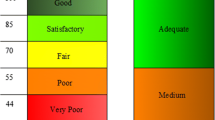Abstract
Currently, Palestinian municipalities define pavement conditions using detailed visual inspection. This procedure is expensive and time consuming. The new proposed model contributes to reducing both time and cost incurred by identifying a new model that considers machine-learning techniques rather than the conventional ASTM procedure. The authors studied the most common six pavement defects. These defects are alligator cracks, patching, longitudinal, and transverse cracks, shoving, and potholes. An optimized hybrid model is developed to determine the Pavement Condition Index (PCI) based on the FHWA Long-Term Pavement Performance (LTPP) database. The model follows a cascade architecture with three classical machine learning models followed by a neural network model. Using the neural network model as a second stage in the chain allows the model to focus its power on the nonlinear curve estimation to further reduce the errors. Finally, out-of-sample performance analysis as well as a cross-validation analysis is carried out to check the robustness of the model. The results show that the model estimates PCI with high degree of accuracy.













Similar content being viewed by others
Data Availability
Data, models, and codes that support the findings of this study are available from the corresponding author upon reasonable request.
References
ASTM D6433-11 (2011) Standard practices for roads and parking lots pavement condition index surveys. American Society for Testing and Materials. Pennsylvania, USA
Bianchini A, Bandini P (2010) Prediction of pavement performance through neuro-fuzzy reasoning. Comput Aided Civil Infrastruct Eng 25(1):39–54
Bosurgi G, Trifirò F (2005) A model based on artificial neural networks and genetic algorithms for pavement maintenance management. Int J Pavement Eng 6(3):201–209
Ceylan H, Bayrak MB, Gopalakrishnan K (2014) Neural networks applications in pavement engineering: a recent survey. Int J Pavement Res Technol 7(6):434
Cheng H, Wang J, Hu Y, Glazier C, Shi X, Chen X (2001) Novel approach to pavement cracking detection based on neural network. Transp Res Rec 1764(1):119–127
Eldin NN, Senouci AB (1995) A pavement condition-rating model using backpropagation neural networks. Comput Aided Civil Infrastruct Eng 10(6):433–441
Galehouse L, Moulthrop JS, Hicks RG (2003) Principles of pavement preservation: definitions, benefits, issues, and barriers. TR News, (228)
Hajj EY, Loria L, Sebaaly PE, Borroel CM, Leiva P (2011) Optimum time for application of slurry seal to asphalt concrete pavements. Transp Res Rec 2235(1):66–81
Hall JW, Grau RW, Grogan WP, Hachiya Y (1991) Performance indications from army airfield pavement management program. In: Pavement management implementation. ASTM International
Hossain M, Gopisetti L, Miah M (2019) International roughness index prediction of flexible pavements using neural networks. J Transp Eng B Pavements 145(1):04018058
Huang YH (1993) Pavement analysis and design
Karim FM, Rubasi KAH, Saleh AA (2016) The road pavement condition index (pci) evaluation and maintenance: a case study of yemen. Org Technol Manag Const Int J 8(1):1446–1455
Marcelino P, de Lurdes Antunes M, Fortunato E, Gomes MC (2021) Machine learning approach for pavement performance prediction. Int J Pavement Eng 22(3):341–354
Plati C, Georgiou P, Papavasiliou V (2016) Simulating pavement structural condition using artificial neural networks. Struct Infrastruct Eng 12(9):1127–1136
Quinlan JR (1986) Induction of decision trees. Mach Learn 1(1):81–106
Roberts CA, Attoh-Okine NO (1998) A comparative analysis of two artificial neural networks using pavement performance prediction. Comput Aided Civil Infrastruct Eng 13(5):339–348
Shah YU, Jain S, Tiwari D, Jain M (2013) Development of overall pavement condition index for urban road network. Proced Soc Behav Sci 104:332–341
Shahin MY (1997) Paver asphalt distress manual. Construction Engineering Research Lab (ARMY) Champaign, IL
Shahin MY, Kohn SD (1982) Overview of the paver pavement management system and economic analysis of field implementing the paver pavement management system. Technical report, Construction Engineering Research Lab (ARMY) Champaign, IL
Shahin MY, Walther JA (1990) Pavement maintenance management for roads and streets using the PAVER system. Construction Engineering Research Lab (ARMY) Champaign, IL
Terzi S (2006) Modeling the pavement present serviceability index of flexible highway pavements using data mining. J Appl Sci 6(1):193–197
Witczak MW, Yoder EJ (1975) Principles of pavement design. Wiley, Hoboken
Wu K (2015) Development of PCI-based pavement performance model for management of road infrastructure system. Arizona State University, Arizona
Yamany MS, Saeed TU, Volovski M, Ahmed A (2020) Characterizing the performance of interstate flexible pavements using artificial neural networks and random parameters regression. J Infrastruct Syst 26(2):04020010
Younos M, Abd El-Hakim R, El-Badawy S, Afify H (2020) Multi-input performance prediction models for flexible pavements using ltpp database. Innov Infrastruct Solut 5(1):1–11
Author information
Authors and Affiliations
Corresponding author
Ethics declarations
Conflict of interest
The authors declare that they have no conflict of interest.
Rights and permissions
About this article
Cite this article
Issa, A., Sammaneh, H. & Abaza, K. Modeling Pavement Condition Index Using Cascade Architecture: Classical and Neural Network Methods. Iran J Sci Technol Trans Civ Eng 46, 483–495 (2022). https://doi.org/10.1007/s40996-021-00678-9
Received:
Accepted:
Published:
Issue Date:
DOI: https://doi.org/10.1007/s40996-021-00678-9




